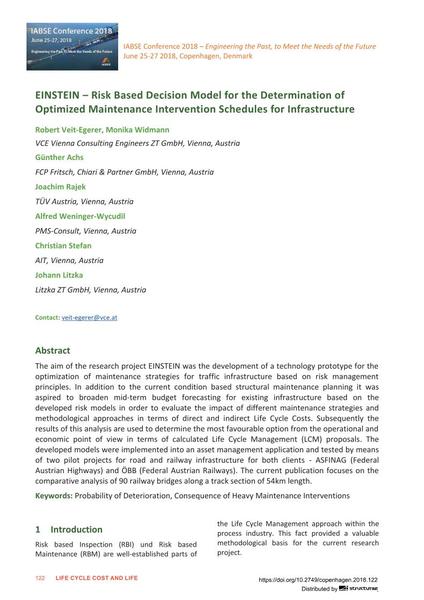Einstein - Risk-Based Decision Model for the Determination of Optimized Maintenance Intervention Schedules for Infrastructure

|
|
|||||||||||
Bibliografische Angaben
| Autor(en): |
Robert Veit-Egerer
(VCE Vienna Consulting Engineers ZT GmbH, Vienna, Austria)
Monika Widmann (VCE Vienna Consulting Engineers ZT GmbH, Vienna, Austria) Günther Achs (FCP Fritsch, Chiari & Partner GmbH, Vienna, Austria) Joachim Rajek (TÜV Austria, Vienna, Austria) Alfred Weninger-Wycudil (PMS-Consult, Vienna, Austria) Christian Stefan (AIT, Vienna, Austria) Johann Litzka (Litzka ZT GmbH, Vienna, Austria) |
||||
|---|---|---|---|---|---|
| Medium: | Tagungsbeitrag | ||||
| Sprache(n): | Englisch | ||||
| Tagung: | IABSE Conference: Engineering the Past, to Meet the Needs of the Future, Copenhagen, Denmark, 25-27 June 2018 | ||||
| Veröffentlicht in: | IABSE Conference Copenhagen 2018 | ||||
|
|||||
| Seite(n): | 122-129 | ||||
| Anzahl der Seiten (im PDF): | 8 | ||||
| DOI: | 10.2749/copenhagen.2018.122 | ||||
| Abstrakt: | The aim of the research project EINSTEIN was the development of a technology prototype for the optimization of maintenance strategies for traffic infrastructure based on risk management principles. In addition to the current condition based structural maintenance planning it was aspired to broaden mid-term budget forecasting for existing infrastructure based on the developed risk models in order to evaluate the impact of different maintenance strategies and methodological approaches in terms of direct and indirect Life Cycle Costs. Subsequently the results of this analysis are used to determine the most favourable option from the operational and economic point of view in terms of calculated Life Cycle Management (LCM) proposals. The developed models were implemented into an asset management application and tested by means of two pilot projects for road and railway infrastructure for both clients - ASFINAG (Federal Austrian Highways) and ÖBB (Federal Austrian Railways). The current publication focuses on the comparative analysis of 90 railway bridges along a track section of 54km length. | ||||
